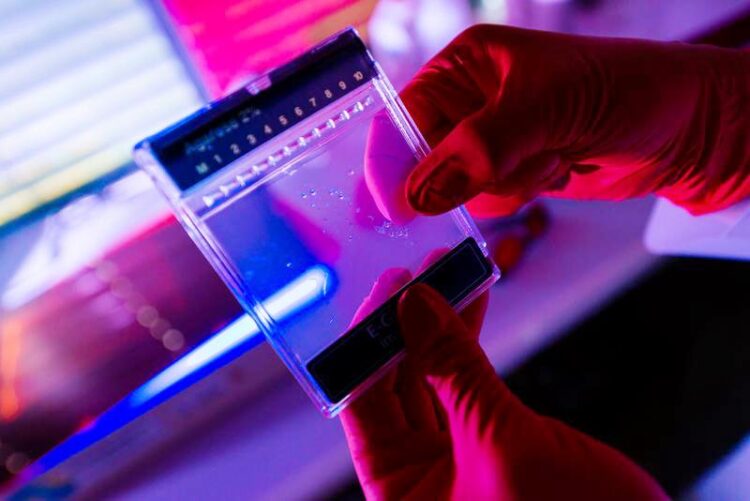Covid-19 genetic risk variant protects against HIV

DNA analytics in the lab
© MPI f. Evolutionary Anthropology
A COVID-19 risk variant inherited from Neandertals reduces a person’s risk of contracting HIV by 27 percent.
The genetic variants we are born with can increase or decrease our risk of falling seriously ill with COVID-19. The major genetic risk variant for severe COVID-19, one we inherited from Neandertals, is surprisingly common. This raises the question whether it may actually be of advantage to carry this variant. A study by Hugo Zeberg, a researcher at the Max Planck Institute for Evolutionary Anthropology (MPI-EVA) in Leipzig, Germany, and Karolinska Institutet in Sweden, now shows that the same gene variant that increases the risk of falling seriously ill with COVID-19 protects from another serious disease – it reduces a person’s risk of contracting HIV by 27 percent.
Some people become seriously ill when infected with SARS-CoV-2 while others have only mild symptoms or no symptoms at all. In addition to risk factors such as advanced age and chronic diseases, like diabetes, our genetic heritage also contributes to our individual COVID-19 severity risk.
In the autumn of 2020, Hugo Zeberg at Karolinska Institutet and MPI-EVA and Svante Pääbo at MPI-EVA showed that we inherited the major genetic risk factor for severe COVID-19 from Neandertals. In the spring of 2021, the same researcher duo studied this variant in ancient human DNA and observed that its frequency has increased significantly since the last ice age. In fact, it has become unexpectedly common for a genetic variant inherited from Neandertals. Hence, it may have had a favourable impact on its carriers in the past. “This major genetic risk factor for COVID-19 is so common that I started wondering whether it might actually be good for something, such as providing protection against another infectious disease”, says Hugo Zeberg, who is the sole author of the new study.
The genetic risk factor is located in a region on chromosome 3 that consists of many genes. There are several genes in its vicinity that encode receptors in the immune system. One of these receptors – CCR5 – is used by the HIV virus to infect white blood cells. Zeberg found that people who carried the risk factor for COVID-19 had fewer CCR5 receptors. This led him to test whether they also had a lower risk of becoming infected with HIV. By analysing patient data from three major biobanks (FinnGen, UK Biobank and Michigan Genomic Initiative) he found that carriers of the risk variant for COVID-19 had a 27 percent lower risk of contracting HIV. “This shows how a genetic variant can be both good and bad news: Bad news if a person contracts COVID-19, good news because it offers protection against getting infected with HIV”, says Zeberg.
However, since HIV only arose during the 20th century, protection against this infectious disease cannot explain why the genetic risk variant for COVID-19 became so common among humans as early as 10,000 years ago. “Now we know that this risk variant for COVID-19 provides protection against HIV. But it was probably protection against yet another disease that increased its frequency after the last ice age”, Zeberg concludes.
Contact
Dr. Hugo Zeberg
Original publication
Media Contact
All latest news from the category: Life Sciences and Chemistry
Articles and reports from the Life Sciences and chemistry area deal with applied and basic research into modern biology, chemistry and human medicine.
Valuable information can be found on a range of life sciences fields including bacteriology, biochemistry, bionics, bioinformatics, biophysics, biotechnology, genetics, geobotany, human biology, marine biology, microbiology, molecular biology, cellular biology, zoology, bioinorganic chemistry, microchemistry and environmental chemistry.
Newest articles

Sea slugs inspire highly stretchable biomedical sensor
USC Viterbi School of Engineering researcher Hangbo Zhao presents findings on highly stretchable and customizable microneedles for application in fields including neuroscience, tissue engineering, and wearable bioelectronics. The revolution in…

Twisting and binding matter waves with photons in a cavity
Precisely measuring the energy states of individual atoms has been a historical challenge for physicists due to atomic recoil. When an atom interacts with a photon, the atom “recoils” in…

Nanotubes, nanoparticles, and antibodies detect tiny amounts of fentanyl
New sensor is six orders of magnitude more sensitive than the next best thing. A research team at Pitt led by Alexander Star, a chemistry professor in the Kenneth P. Dietrich…





















